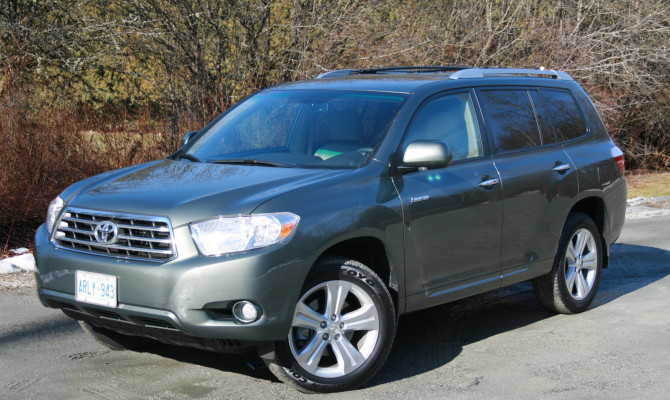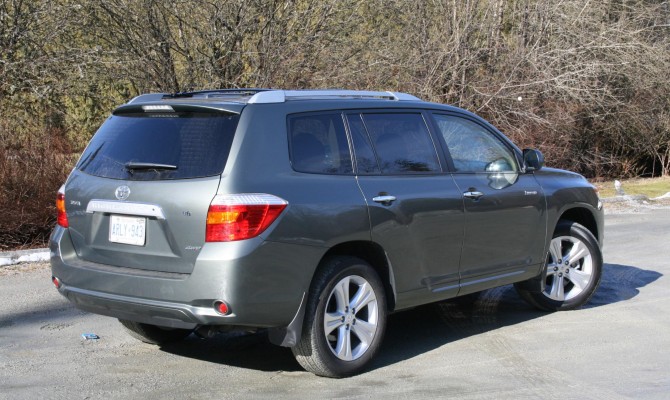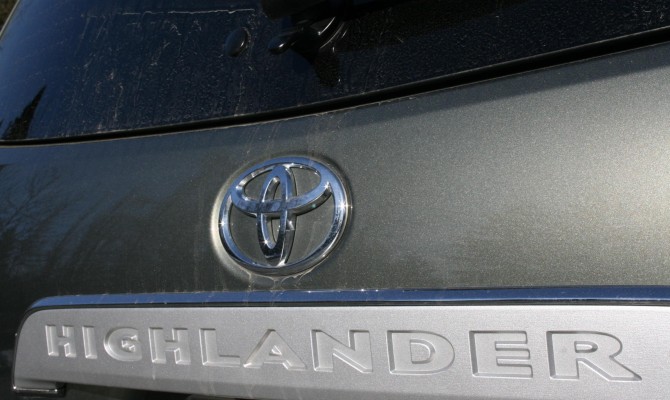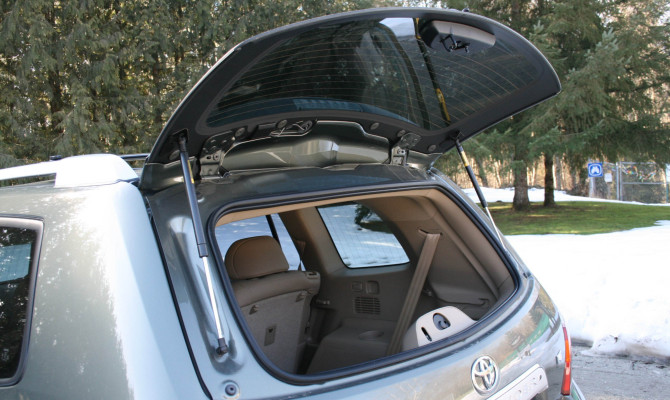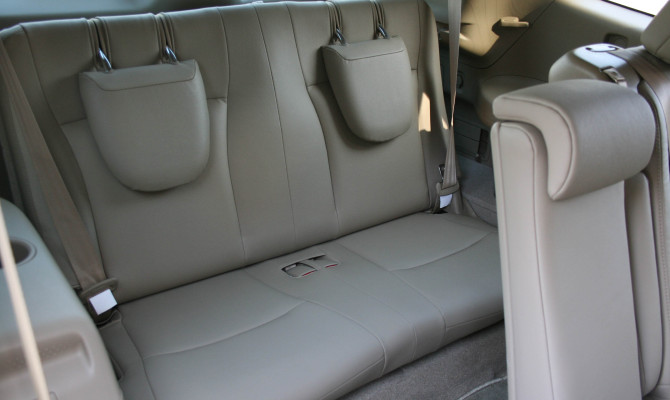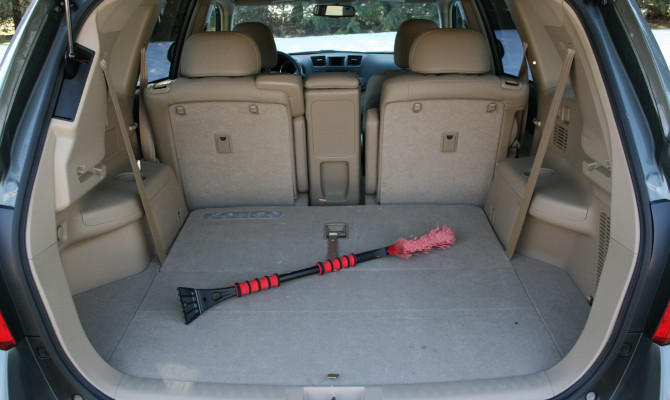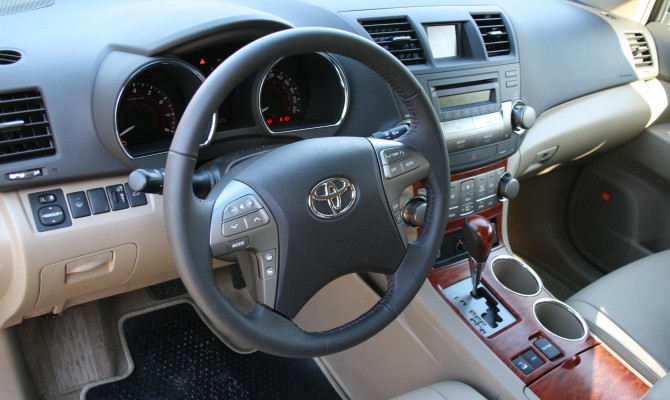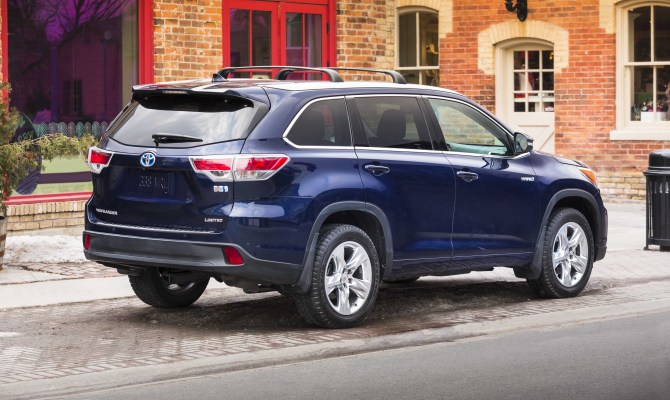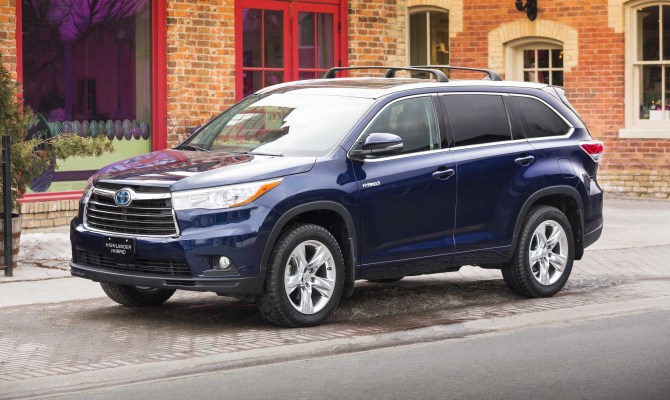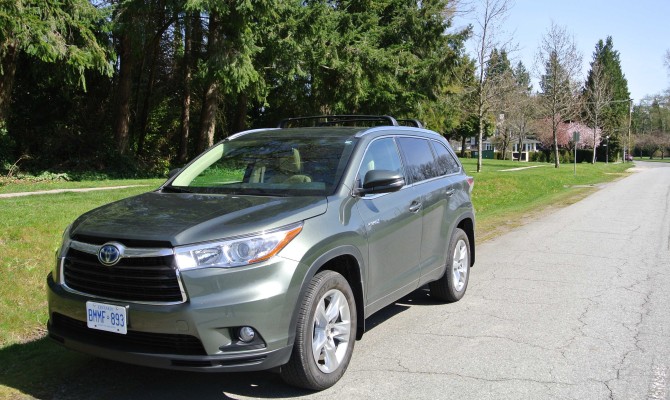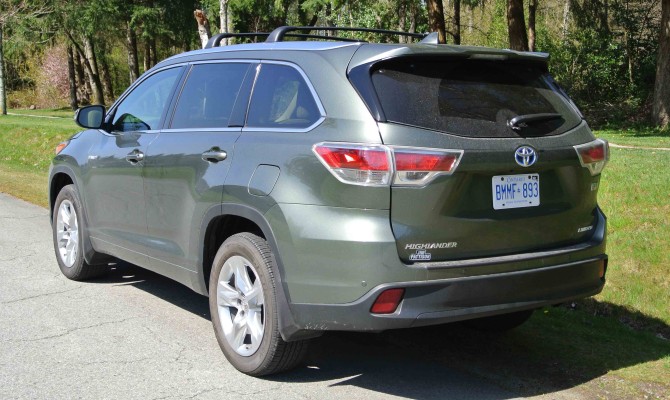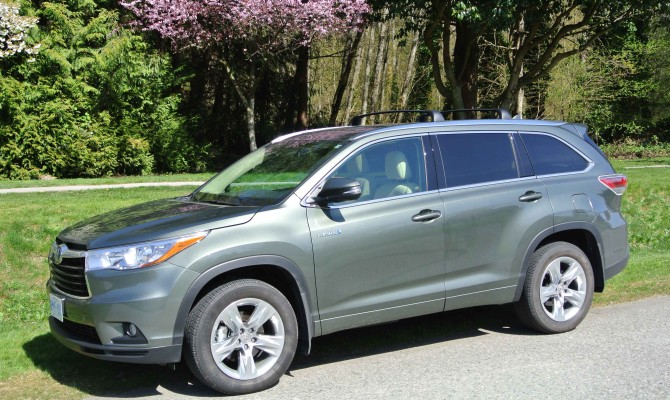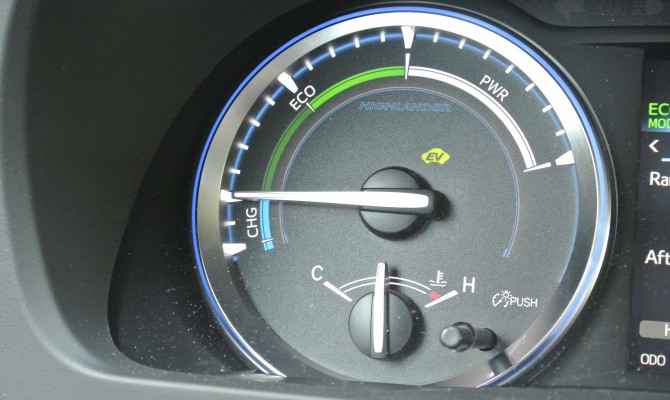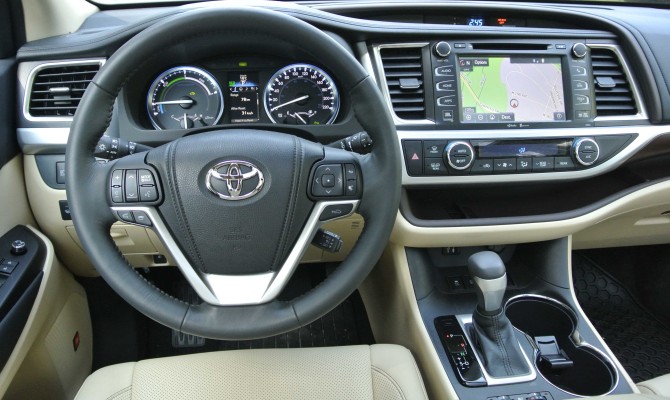“A comfortable and secure all-weather family cruiser, the Toyota Highlander is a low risk purchase with a history of solid reliability and excellent resale value retention.”
Toyota introduced a completely redesigned and more upscale Highlander in 2008 (its mid-sized utility vehicle) that was bigger with three rows of seating, more powerful and more expensive.
Bad timing, as that very same year the world`s economy took an unexpected and spectacular nosedive, which sparked a major consumer trend to scale down.
This model offers has a more rounded shape with pronounced wheel arches and there’s a flip-open rear door window. It`s a handy feature that allows you to drop stuff into the cargo area without opening the large rear door.
The V6 engine versions of Highlander came with four-wheel-drive plus extra goodies like a back-up camera, a power driver’s seat and fog lamps. Above base, the higher trim levels were Sport, Limited and SR5 (only for 2008).
A four-wheel-drive Highlander Hybrid with a gas/electric powertrain was also offered and came in base and Limited trim levels. Hybrid power is provided by a 3.3 litre V6 engine coupled to an electric motor and they have a combined power output of 270 horsepower, which is roughly the same as the regular 3.5-litre V6. The hybrid`s city/highway fuel economy, however, is rated (new five-cycle method) at 8.6 / 9.5 L/100km compared to 13.8 / 10.4 km/100km for the 3.5 litre V6.
Reacting to the new economic reality, in an impressively quick way, Toyota introduced a substantially lower priced and more basic, front-drive Highlander, midway through the ’09 model year. It came with two-row seating and a 2.7 litre 4-cylinder engine mated to a 6-speed automatic transmission. This engine can provide 187 horsepower and 186 lb-ft of torque at 4,100 rpm and its city/highway fuel economy rating is 11.8 / 8.7 L/100km.
Highlander is a ‘Top Safety Pick’ according to the Insurance Institute for Highway Safety, based on its front, side and rear crash tests. Highlander was included in a series of safety recalls (see list), including the famous “floor mat recall”, in response to mysterious defect that supposedly caused unintended acceleration.
No changes were made to the 2010 Highlander, but for 2011, it got revised front and rear styling, with slimmer headlights, a new front grille and new taillights. The Sport model was discontinued and the hybrid version got a (combined 280 horsepower) 3.5L V6. A third-row seat also became standard on all models.
No significant changes were made for the 2012 or 2013 model years, which were the last of this generation Highlander. The completely revised 2014 Highlander, a sleeker family-friendly seven passenger cross utility, recorded its best sales year ever.
A comfortable and secure all-weather family cruiser, the Toyota Highlander is a low risk purchase with a history of solid reliability and excellent resale value retention.
Price Check: 2008 – 2013 Toyota Highlander (April 2015)
Year Edition Expect to Pay Today
2008 V6 4WD Limited $21,000 to $25,000
2009 V6 4WD Limited $23,000 to $27,000
2010 V6 4WD Limited $25,000 to $29,000
2011 V6 4WD Limited $27,000 to $32,000
2012 V6 4WD Limited $30,000 to $35,000
2013 V6 4WD Limited $33,000 to $38,000
Prices vary depending on a used vehicle’s condition, mileage, usage and history. A complete mechanical check should always be performed by a reliable auto technician prior to purchase.
Safety Recalls: 2008 to 2013 Toyota Highlander:
2008: The driver’s side power window master switch could stick or become inoperative. Dealers will inspect the driver’s power window master switch and apply special grease that inhibits heat build-up, or replace the power window master switch circuit board, as necessary.
2008: Side curtain airbag roll angle sensors may fail. If one roll angle sensor malfunctions, the airbag warning lamp will illuminate and the roll detection system will be suspended. If both roll angle sensors fail simultaneously, the curtain shield airbag and the seatbelt pre-tensioner could inadvertently deploy. Dealers will replace the airbag sensor assembly.
2008: The seatbelt mechanism for the third row seat may revert from its Emergency Locking Retractor (ELR) mode to its Automatic Locking Retractor (ALR) mode, while installing a Child Restraint. Dealers will install a newly designed seatbelt component free of charge.
2008: The seat track, located on the inboard side of the left second row seat, may not fully lock in the forward first and second adjustment positions. Dealers will affect repairs.
2008 – 2010: Electrical circuitry in the steering wheel assembly may become damaged and the driver’s airbag may not function as intended and the instrument panel airbag warning lamp may illuminate. Dealers will replace the spiral cable assembly.
2008 – 2010: If a Toyota optional accessory “tray-type” floor mat is not secured by retaining hooks, or is placed on top of an existing floor mat, it may move forward and interfere with the accelerator pedal. Owners were notified to remove the “tray-type” floor mats and given a reimbursement.
2008 – 2010: The accelerator pedal may become stuck in the wide-open position due to an unsecured or incompatible driver’s floor mat. Dealers will reconfigure the shape of the accelerator pedal, modify the floor underneath the accelerator pedal and/or install a brake override system.
“Good on fuel and perfect for family transportation…”
The 2015 Toyota Highlander Hybrid is truly a big people mover.
There are three models available; the Hybrid LE, XLE, both of which carry up to eight passengers and the Hybrid Limited that I drove maxes out at seven.
Looks:
The designers have given the Highlander a makeover for 2015 with a new grille and more sculpted headlights along with a larger rear spoiler. This year, 17-inch alloy wheels are standard with 19-inch alloy wheels available on the Limited and XLE models.
In The Cab:
Standard features on all Highlander models include third row seating, air conditioning; front seats with height-adjustable active head rests and eight-way (10-way on the Limited) adjustable driver’s seat. The long list of standard features includes: power door locks and windows with driver’s window jam protection and auto up/down feature; cruise control; multi-function keyless entry system; UV reduction windshield and rear privacy glass; illuminated entry system.
The Limited model features a panoramic moonroof that brings in lots of natural light to the cabin.
The LE model features a standard AM/FM/CD audio system with six-speakers; XLE and Limited models have an AM/FM/six disc in dash CD changer with six speakers, MP3/WMA playback capability and satellite radio capability. All audio systems are equipped with a USB audio input.
All models have a backup camera. The lift gate has selectable memory height settings so gone are the days of walking into the edge of the gate without looking.
Safety first:
The Highlander comes standard with seven airbags. These include advanced driver and front passenger airbags, front seat-mounted side airbags and a driver’s knee airbag. Roll-sensing side curtain airbags help to protect the occupants of all three rows in the event of side collisions or vehicle rollovers. All Highlander models are now standard equipped with front active headrests.
Toyota has also added Smart Stop technology, lane departure alert, blind spot monitor, and rear cross traffic alert.
Roadworthy:
The tester has a higher spring rate and a high damping force type shock absorber that delivers a firm but comfortable ride. Cornering is where you really feel the difference. Missing is the typical SUV roll you experience with some other SUVs. There is lots of power and it is very easy to find yourself over the speed limit in a hurry!
I noticed that in Econ mode the heater does not put out as much force, so on a cold day you will have to turn this off to get a full amount of heat. There is lots of room inside for the whole family, especially with the addition of the third row seating.
The Hybrid comes with a towing prep package that includes a large radiator, transmission oil cooler, heavy-duty battery and towing wire harness.
Verdict:
Good on fuel and perfect for family transportation.
Power:
The Hybrid combines a 3.5 litre engine with a high-speed electric motor that produces a peak 280 horsepower.
Warranty support:
Basic 60,000 km
Powertrain 100,000 km
Corrosion Unlimited
Pump frequency:
HYBRID Limited – 8.6/8.5 L/100 km (city/highway)
Sticker price:
Highlander Hybrid LE from $44,015
Highlander Hybrid XLE from $46,440
Highlander Hybrid Limited as tested $52,990
It is competent, potent and a fabulous sport utility vehicle even in Eco Mode where the fun is a little bit restricted…
The all-new, third generation 2014 Toyota Highlander Hybrid Limited AWD tips the scale at 2,200 kg (4,850 lbs.)
It’s not a svelte vehicle.
Inside, this Highlander can carry up to seven passengers.
It’s not a cramped vehicle.
And behind the third row of seats, there’s a cargo capacity of 385L.
It’s an accommodating vehicle.
So when I knew that I’d be logging more than 1,000 kilometres in a week, perhaps you’d think I’m a little crazy to want to take this (relatively) heavy and large SUV along for the ride. Normally, I would too. But there’s a word in its name that made me want to take this beauty of a beast for the long haul: Hybrid.
As I entered the Flaxen (aka beige) adorned cabin, I reached for the “Eco Mode” button underneath the redesigned centre stack. I gave that a push.
The Eco mode is a feature that lessens the throttle response in an effort to help save fuel. You can still do all your normal daily driving duties, it just helps you keep money where it should be: in your wallet. And keeps the fuel where it should be: in the tank.
Granted, in Eco Mode, it doesn’t give you the peppy acceleration you might like. Then again, if prompt acceleration is what you’re after, skip the Eco Mode and that’s exactly what you’ll get.
Whether I was driving in the city or on the highway, the Highlander has a smoothness to it that makes me love being behind the wheel. It cruises effortlessly atop the pavement and makes the driver and passengers feel at ease. Especially when you know you’re going the distance.
I even had one passenger say to me, “If we were in here any longer, I could’ve fallen asleep! It’s so comfortable.”
Good thing they weren’t driving.
The suspension is composed of front Macpherson struts and a rear double wishbone type, trailing arms set up. Toyota gets an A+ for ride comfort. And it’s arguably one of the best in its class.
Aiding in establishing a serene setting is a host of creature comforts like heated front seats, a heated steering wheel, second row captain’s chairs, easy access to the third row, keyless entry, navigation, an 8-inch touchscreen and much more.
We’ve already established its size, and while it fits up to seven, it doesn’t feel that big to drive. Sure, you need to make sure you watch its width but manoeuvring it around in parking lots isn’t a chore at all. Thanks to its rack and pinion-type, electric power steering, you can move around graciously.
Though this is not my first hybrid SUV that I’ve tested, I am always excited to see how well these machines perform in regards to fuel economy.
After all, there’s a 3.5L, V6 engine under the hood, which is then matched with an electric motor, a Sealed Nickel-Metal Hydride battery and an Electronically Controlled Continuously Variable Transmission (ECVT). The result is a net 280 horsepower. There’s also a 1,587 kg (3,500 lbs.) towing capacity.
Looking at the estimated fuel results, it’s rated at 6.8L/100km in the city and 7.2L/100km on the highway. Keep in mind the aforementioned stats about its size and weight and those numbers are really impressive.
My real world numbers? A combined average of 8.9L/100km. Not bad. Not bad at all. Most of my driving was done on the highway so the hybrid system doesn’t have a chance to run off electricity alone at those speeds.
Oh, and it’s all-wheel drive. Sun or snow, this SUV is ready for it all.
With fuel prices hovering around the $1.50/litre mark, the more kilometres I can get out of a tank, the better. And the Highlander Hybrid made me a very happy gal.
The conclusion: The 2014 Toyota Highlander Hybrid Limited AWD is competent, potent and a fabulous sport utility vehicle even in Eco Mode where the fun is a little bit restricted.
The MSRP for the 2014 Toyota Highlander Hybrid Limited AWD is $52,695.
Visit www.toyota.ca for more information.
Recent Comments
- { Enjoyed your Forest of Bowland in the BMW X5M, particularly the photo of the BMW in front of the main part of Stonyhurst College where... }
- { Bantam designed the Jeep, not Willy's or Ford. The American military gave the original Bantam prototype to Willys and Ford to copy. There is plenty... }
- { All Escalades come with a 6.2-lilter V8 engine that produces 420 horsepower. A six-speed automatic is the only transmission offered and drives the rear wheels.... }
- { Alexandra is an excellent journalist. }
Popular Posts
- Journey to a ‘Sparkling’ Luxury Okanagan Resort “Four lucky readers will put a Dodge Journey’s weekend-...
- The Need For Speed: Hike Those Highway Limits More than half of those polled believe the province sho...
- Drives-U-Crazy… Erratic drivers. An early morning drive from Kelowna to Vancouver is nor...
- Readers Respond: The Pros and Cons of Increasing B.C. Speed Limits Increasing the speed limits will only increase risk to...
- Honda CR-V Review: The Compact Crossover To Get Things Done The CRV is a very stylish and aerodynamic crossover veh...


